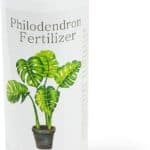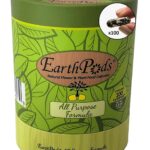In the world of large houseplants, Philodendrons are considered gems because of their majestic, large-spanning leaves and overwhelming structure.
However, they will quickly lose this vigor when provided with less or more soil nutrition.
Fertilizing the Philodendron plant is essential, but over-fertilizing, especially with the wrong food, may even kill the plant.
However, the fertilizer ratio, application, and frequency will largely depend on the Philodendron species you are trying to grow.
Remember, it is easier to overfeed than underfeed your plant, causing its untimely death.
Read on to find out how to best fertilize your Philodendrons and overcome common issues.
Table of Contents Show
Fertilizer for Philodendron: Everything You Need to Know
Philodendrons are the gem of large flowering plants with hundreds of sub-species equally known for their foliage, appearance, and vigor.
Some may boast life-size leaves with glossy green appearances, such as Philodendron Selloum and P. maximum, while others display bushier, dark foliage like Lemon Lime Philodendron.
These easy-to-grow plants quickly adapt to your homes and thrive indoors while removing harmful air toxins from your home.
However, keeping these vigorous plants looking healthy may be challenging without supplementary nutrition.
Generally, it would help if you fertilized Philodendrons once a month in the growing season, spring and summer, with all-purpose plant food to support growth.
Philodendrons are tropical plants that thrive in their natural rainforest setting, thanks to the microbes-rich humus.
Those lacking essential nutrition quickly show signs of problems through their wilting leaves, stooping stems, and stunted appearance.
On the other hand, over-fertilizing will cause fertilizer burn, which may even kill the plant.
Signs your Philodendron has Fertilizer Issues
As previously mentioned, Philodendrons quickly show signs of fertilizer problems through their foliage and appearance.
When improperly fertilized, philodendrons exhibit the signs and symptoms listed below.
1. Slow Growth and Small New Leaves
Nutrient deficiency in Philodendrons will negatively affect their growth and appearance.
The lack of nitrogen will lead to small new leaves and slow growth on most Philodendron plants.
Most tall Philodendron species will grow up to 4 inches a week in spring and summer, but underfed plants are less likely to maintain the growth rate.

Similarly, pale new leaves indicate the plant is not getting sufficient trace minerals such as Calcium and Magnesium.
However, remember not all Philodendrons grow large leaves. Some may boast small bushier foliage.
2. Falling Leaves
Premature leaf drops may also indicate under fertilized Philodendron plant.
The malnourished Philodendron will fail to supply essential nutrients to the leaf required for even growth.
Hence, the leaf will begin dropping as nutrients become scarce.
Moreover, the malnourished Philodendrons are less likely to grow blossoms and fruits.
3. Stunted Growth
Although many problems may lead to stunted Philodendron growth, over-fertilization remains one of the primary issues.
Too much fertilization may lead to root burn and bacterial growth, affecting the plant’s ability to process food (water and light).
Therefore, over-fertilizing Philodendron with undiluted plant food or frequent feeding is terrible.
4. Burned or Dried Leaf Margins
Brown leaf edges or dried margins indicate root problems in Philodendron plants.
Those fed with too much fertilizer will witness fertilizer burn in leaves, where the leaf edges will turn brown.

Overfertilization leads to the high salt content in the soil that chokes the root from taking in water or oxygen.
Therefore, the leaves will begin transpiring (losing water), leading to dried and brown edges.
5. Chlorosis and Wilting
Like developing brown edges, the over-fertilized Philodendron will begin exhibiting yellowing leaves.
The high salt buildup in the soil usually accumulates on topsoil, making it harder for the roots to take up water. It will burn the leaves leading to chlorosis (yellowing).
Similarly, the burnt leaves will begin wilting as they lose a significant amount of water.
Read more: Why are my Philodendron Leaves Yellow?
6. White Crust on Soil
Over or frequent fertilization will increase the soil salinity, where the white crust will form on the soil surface.
A white substance or salty crust on the soil indicates excess fertilization.

Moreover, it means the roots are incapacitated and may struggle to take up water and oxygen.
Without immediate treatment, the salinity will continue damaging the root and plant’s appearance.
When to Fertilize Philodendron?
Generally, it would help to fertilize your Philodendrons every month in spring and summer to boost their growth.
You would need to apply a monthly fertilizer, especially with a liquid formula, but keep the application to once in three months when using granular formula.
It is usually best to start with a commercial liquid fertilizer monthly and adjust the frequency based on the plant’s appearance.
If the leaves seem smaller than usual and malnourished, consider fertilizing them twice a month with a diluted liquid formula.
Similarly, avoid applying fertilizer to over-fertilized plants to prevent further chemical burn and soil salinity.
However, you should avoid fertilizing in fall and winter when the plant goes dormant and get the soil tested every 1 to 2 years before fertilizing.
Note: Philodendrons require a pH level between 5.0-6.0 to retain the maximum amount of nutrients from the soil.
NPK Values of Fertilizer
Philodendrons love nutrients and may falter when you fail to provide essential macro and micronutrients.
Applying plant food with essential minerals in the appropriate ratio is vital to achieving healthier growth.
Hence, you should know what and how much to feed your Philodendron.
Generally referred to as NPK, the macronutrients Nitrogen (N), Phosphorus (P), and Potassium (K) are mixed in different proportions to make fertilizers.
| Fertlizer | Uses |
|---|---|
| Nitrogen (N) | Plant's growth and the formation of lush leaves. |
| Phosphorus (P) | Production of roots, development of flowers and fruits, and strengthen plant stems. |
| Potassium (K) | Movement of water and nutrients in your plants, as well as increasing disease resistance. |
Philodendrons prefer an NPK ratio of 20-20-20 when using all-purpose, balanced fertilizer, or particularly 3-1-2 to induce specific growth.
As indoor grown Philodendrons are less likely to blossom, you can avoid using a fertilizer with significant phosphorus.
On the other hand, more nitrogen and potassium content, such as NPK 3-1-2, will help achieve larger, greener leaves and retain more water and nutrients.
Micronutrients and Trace Minerals
Similarly, Philodendrons require micronutrients and trace minerals to maintain their immunity.
They mainly provide energy to fight off diseases and support ongoing tissue development.
| Micro and Trace Minerals | Benefits |
|---|---|
| Calcium, Magnesium, and Sulfur | 1. They help maintain the plant’s immune system. 2. The nutrients particularly boost metabolism and helps retain nutrients. |
| Copper, Iron, and Zinc | 1. They help induce quicker and bushier growth. 2. The nutrients help maintain healthy root conditions and soil microorganisms. |
You can find many organic and synthetic fertilizers that help provide these minerals.
Otherwise, you can also create an organic fertilizer home using household items.
Best Commercial Fertilizer for Philodendrons
Consider choosing organic fertilizer rich in macro and micronutrients for healthy vertical spread and leaf growth.
Many gardeners choose synthetic fertilizers as they offer quicker results, but they may be bad.
Using synthetic fertilizer increases the soil’s chemical residue, killing healthy bacteria and damaging the roots.
If you are confused about the best Philodendron fertilizers, here are a few recommendations.
| Organic Fertilizer | Features | Image |
|---|---|---|
| Philodendron Fertilizer 3-1-2 | The 3-1-2 formula boost nitrogen and potassium content to the soil and roots for optimal growth. It will treat green, lime, plantvine, split leaf, velvet, and pink princess philodendron. |  |
| Triple 10 All Purpose Liquid Fertilizer | The 10-10-10 formula with amino acids (5.5%) and seaweed extract helps with growth in all stages of plant growth. Water generously and continue using every 2 weeks. |  |
| EarthPods Premium Indoor Plant Food | All purpose houseplant food is a formulation of organic plant nutrients, soil humates, and trace minerals. Use as slow release fertilizers. |  |
| Miracle-Gro Indoor Plant Food | The balanced plant food is appropriate for all houseplants and applicable for all stages of plant growth. Dilute with the water and apply directly to the soil every 2 weeks. |  |
| EasyPeasy Liquid Indoor Plant Food | The 4-3-4 formula promotes green leaf growth and strong root system. The high concentration should be diluted before applying directly to the soil. |  |
How to Prepare Homemade Fertilizer for Philodendron?
If you are not up for using commercial products, you can resort to preparing your natural fertilizer for philodendrons.
The advantage is that you can use organic matter produced in your kitchen or garden to produce natural fertilizer.
Moreover, homemade fertilizer contains more beneficial soil microbes and bacteria for prolific root growth.
Here are a few items you can use to prepare homemade Philodendron fertilizer.
| Matter | Specification |
|---|---|
| Egg shells | Eggshells is a prime calcium source that you can crush into small matters and mix into the soil. Otherwise, throw it into the compost pile with other vegetable and garden residue. |
| Coffee Grounds | Used coffee grounds make great fertilizer matter as it naturally contains nitrates, potash, and phosphorus. You can pile the top soil with coffee grounds or throw them into the compost pile to prepare a finer mulch. |
| Used Aquarium Water | Used aquarium water contains natural algae and plenty of nitrates that you can pour directly into the soil. |
Steps to Prepare Homemade Fertilizer for Philodendrons
- Get a Lomi electric composter and fill it with fresh fruit and vegetable waste, including coffee grounds and egg shells.
- Add a Lomi pod and 50ml water, activating the “Grow mode” cycle.
- After a few hours, you will have nutrient-rich dirt.
Otherwise, prepare a fertilizer the old-fashioned way.
- Make a compost pile in your backyard under the ground or in a compost bin.
- Add fresh fruit and vegetable scraps, including coffee grounds, banana peels, tea bags, etc.
- Every 2-3 weeks, break the compost by adding a splash of water and turn it using a shovel.
After a few months, you will have dark, crumbly manure-like compost ready for use.
Do you want to learn more about utilizing coffee grounds as a soil amendment? Here’s an article about the Ultimate Guide to Using Coffee Grounds for Houseplants.
Things to Keep in Mind While Fertilizing your Philodendron
As previously mentioned, use the recommended formula to fertilize your Philodendron every two weeks or a month.
When applying the formula every two weeks, dilute it to a 1:1 ratio using water before pouring it into the soil.
- Fertilize only in spring and summer when they are witnessing active growth.
- Be careful not to over-fertilize your Philodendrons.
- It is preferable to fertilize in low amounts at regular intervals than in large quantities at the long gap.
- Water the soil to allow the fertilizer to reach all around the roots.
- Remember to keep the formula from contacting moist foliage and stem to prevent chemical burns.

Steps to Fertilize Philodendron Properly
Here is how to effectively apply fertilizer to Philodendrons.
- Remember to remove dried, wilting, or dead foliage to redirect the energy toward new growth.
- Moisten the soil beforehand, so the plant does not confuse fertilizer for humidity.
- Dilute the solution or use it as recommended. Pour the liquid fertilizer evenly over the soil and a few inches from the plant base.
- Ensure to dispose of any remaining water in the saucer.
- In the case of granular or pellets, spread them onto the soil and water thoroughly to allow the soil to break them down.
Top Tips to Treat an Overfertilized Philodendron
You must assess further and diagnose the problems if your Philodendron shows signs of over-fertilization.
Look for multiple signs such as drooping leaves, brown edges, chlorosis, or frail-looking structure.
Otherwise, carefully remove the plant from the pot and inspect the root for visible damages such as dried feeder roots, white molds, and bacterial growth, dark or mushy structure (fungal growth).
- Remove visible salts: Start with removing any visible fertilizer on the topsoil, such as salt crusts, using a spoon or spatula.
- Leach the soil with water: Set the pot in the sink and run water thoroughly to flush out salts. Repeat the process 2-3 times, but allow the soil to drain thoroughly.
- Remove damaged foliage: Trim-wilted or scorched leaves as it allows the afflicted plant to develop new foliage more quickly.
- Transplant to fresh soil mix: Remove the plant and grow it in a new potting mix if the problem does not subside even after a few weeks.
- Avoid Fertilizing: Stop the fertilizing process until the plant has revived, and always follow the manufacturer’s guide before applying.

Conclusion
Over-fertilizing is more likely than under-fertilizing Philodendrons because most gardeners forget to monitor the application frequency.
If you do not wish to distress your beautiful Philodendrons, consider assessing their condition before fertilizing.
Always choose organic fertilizer (commercial or homemade) packed with macro and micronutrients, as mentioned in this guide.
However, follow the manufacturer’s guidelines before applying to avoid over-fertilization.
Read more: Ultimate Care and Grow Guide for Philodendron
